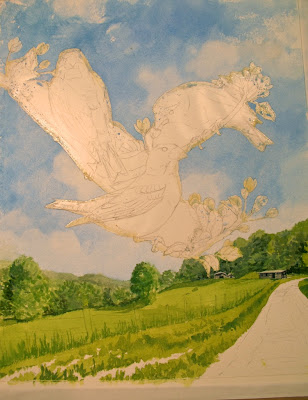ABA Bird of the Year, Painting Part Two
Sunday, March 25, 2012
Here’s what I use for masking out areas I don’t yet want to paint. Frisket Film is a transparent plastic film with low-tack adhesive on back that sticks to the watercolor paper. The artist cuts it in the desired shape with a small X-acto knife, then places it over the area to be masked. Masking the birds was a bit of an adventure. I cut one big piece of masking film by Frisket, and applied it to the paper. Frisket doesn’t much like to stick to the irregular surface of cold press watercolor paper, and that’s a big problem, because it’ll let paint creep under and ruin your nice white space for the birds and flowers. So I engineered the leaves and buds so they intersected the birds fairly smoothly and made one nice big area, and cut the shape a little smaller than needed. Then I ran around the outside of the big, irregular shape with liquid masking compound (I use Incredible White Mask) which has the consistency of thick whipping cream, but dries to a clear, rubber-cement like finish. This effectively seals the edges of the Frisket film and prevents the wash from creeping under it.
The masking compound, after it dries, can be rolled off with the finger or an eraser when you’re ready to remove it. In this case, it did a lovely job of sealing the edges. My results vary widely, and sometimes paint creeps under my mask no matter what I do. This time, I lucked out and got to skip the step where I peel off the masking film and spend a half-hour scrubbing out all the places where the wash seeped under it.
Time to paint the sky!
ABA President Jeff Gordon had requested a spring scene, something other than the typical snow scene most people are used to seeing. I wanted an active sky, a spring sky, a sky that could change and get overcast in a few minutes, so I used lively brushwork on paper that had been dampened by a fine mist from my trusty spray bottle. I didn’t worry about getting it all perfectly even. The sky outside the day I painted this was similar, so I just looked at the random cloud shapes and didn’t worry about where they were as I painted; I just laid them in as it felt right. I did a little scrubbing and lifting of the blue wash to better define the clouds, but I really didn’t want them to compete with the birds, so I kept them pretty filmy. Once a wash like this dries you can’t go back into it and work on it much, so when it was done it was done.
One thing I remember about EVGR is that they always seemed to stay so late in the spring that you started to hope they were going to breed. I remember seeing them in flowering trees in W. MA and even hearing them singing! So I decided to put them in a full-on early May scene, with the trees all leafing out and the grass already getting high along the fencerow. It could be anywhere where EVGR breed—Vermont or Maine, but it’s a scene from not far from where I live in SE Ohio, on Tick Ridge. Painting as I was in late January, I can’t tell you how wonderful it was to waller around in springtime for the time it took to paint this. I could feel the tall grass and the warm breeze and smell the unfolding leaves, that green smell when the sun hits everything.
|
Widget for blogger by Way2Blogging | Via Spice Up Your Blog Gadgets
|










2 comments:
whenever we visit Hartwick Pines State Park, we love to find the evening groesbeaks and the scarlet tanagers, along with the usual groesbeaks, jays, and woodpeckers. We never stop for more than a couple hours, but it's so beautiful!
That road looks frighteningly familiar. Haven't we seen that exact landscape as a photo on this blog in the not-too-distant past? Perhaps with a comment along the lines of "I must paint this scene"?
(I think you may have left out a dog, though.)
;o)
Post a Comment